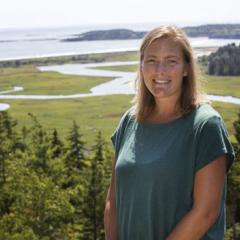Can small-scale closed areas increase scallop populations? A collaborative project with scallop fishermen
In June 2013, I had the opportunity to organize a collaborative research project with a number of partner organizations and some scallop fishermen. This project has been some of the most rewarding work I have done to date because it brings a diverse group of people to the table who are all genuinely interested in sustaining the state's scallop resource and would like to better understand how small-scale closed areas might be an effective management tool to help do so.
It all started with a group of Midcoast Maine scallop fishermen who decided to close a small area of western Penobscot Bay to harvesting for three years starting in 2013. Working directly with scallop managers from the state's Department of Marine Resources (DMR), the fishermen identified the area's boundaries. The closure was officially implemented on October 10, 2013 (more information about closures in the scallop fishery is available here). DMR and other organizations, including the Island Institute, Penobscot East Resource Center, Dr. Wahle's lab at The University of Maine, Maine Sea Grant, Husson University, and Dr. Stokesbury's lab at the University of Massachusetts at Dartmouth developed monitoring protocols to gather baseline data from inside and outside of the closed area with the objective of assessing the effectiveness of the closure in rebuilding local scallop populations. In October and November 2013 the research team, working from fishing vessels, completed five days of dive surveys and two days of drop camera work. In addition, we deployed spat bags which will be collected and processed (we will measure and count the juvenile scallops caught in the bags) in May 2013 to understand general source-sink dynamics in the Lower Muscle Ridge area of Penobscot Bay.
I will continue to coordinate this project through the Hurricane Island Field Research Station and work with the fishermen and other project partners this summer to repeat surveys and analyze the data collected to date. We hope to see an increase in scallop populations inside the closed area, indicating that this particular small-scale targeted closure may be an effective management tool to protect scallop populations near the Lower Muscle Ridge Channel. However, we may find that the designated closed area is not actually increasing scallop populations and should therefore be re-opened.... stay tuned!
This post first appeared on the Hurricane Island Foundation's website. We invited Caitlin Cleaver to republish it here as an example of the collaborative work our Fellows do in the area of citizen science
